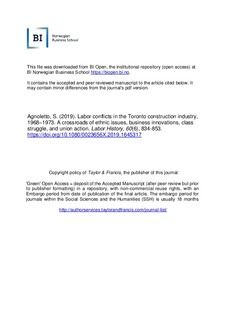Labor conflicts in the Toronto construction industry, 1968?1973. A crossroads of ethnic issues, business innovations, class struggle, and union action
Journal article, Peer reviewed
Permanent lenke
http://hdl.handle.net/11250/2633248Utgivelsesdato
2019Metadata
Vis full innførselSamlinger
- Publikasjoner fra CRIStin - BI [1015]
- Scientific articles [2181]
Sammendrag
This article concerns a case study in labor history which represents an interesting example of union action in a workers’ community characterized by intersections between ethnic and class belonging.
The focus of the article is on labor conflicts in Toronto’s construction industry between 1968 and 1973. In that period, the Torontonian residential sector represented a sort of ethnic niche dominated by Italian immigrants, who populated this industry both as workers and as contractors. At the same time, important economic, technological, and organizational innovations formed part of this niche. In particular, it refers to the new Toronto real estate boom and to the introduction of new building techniques such as the drywall technique, or concrete forming, as well as business innovations such as the flying form or the creation of teamwork. This article tells the story of successful unionization in a peculiar industry dominated by continuous formal and informal bargaining. Moreover, the powerful presence of the phenomenon of mafiosi and widespread racism made the context still more difficult. In this situation, despite the ambiguities, the final result was the unionization of thousands of workers and the successful signing of collective contracts.
